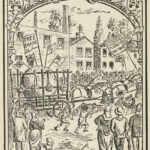8 March 1768: William Evers, engineer-inventor at Swillington (Leeds), advertises his new machine: a windmill for the threshing and grinding of grain

A front view of Evers’ mill (Society for the Encouragement of Arts 1782).
William Evers. 1768/03/08. William Evers, Wire-worker at Swillington, Near Leeds. Leeds Intelligencer. Leeds. Get it:
.Excerpt
William Evers, wire-worker at Swillington, near Leeds, begs leave to acquaint his friends and the public in general, that he continues to make in the most complete manner, his new-invented machine for dressing of corn, rape seed, line seed, etc., which winnows, riddles, and screens all at one operation, and will finish after the thrasher between 20 and 30 bushels in an hour, but will dress in the granary not less than ten quarters by the hour. Likewise, his new-invented machine for dressing of flour for private families, which is so expeditious, that a woman will dress a bushel into three different sorts in twelve minutes; and having been so fortunate as to have his last new-invented machine (wrought in wind, in the manner of a common windmill) for thrashing and grinding of corn, either together or separately, so highly approved of by the Society for the Encouragement of Arts in London, that they have lately ordered him a premium of 50 guineas for his invention; which being a sufficient proof of its utility, he takes the freedom to recommend it also to the favour of the public.
Comment
Comment
Via Howard Benson, whose following item has the remarkable Mr. Evers in 1777 producing some high-yield “Tartarian oats” (Benson N.d.). The Society for the Encouragement of the Arts (now the Royal Society of Arts) received from Evers a scale model:
This mill was invented by Mr. William Evers, of Swillington, near Leeds; in Yorkshire, who erected one of his new-constructed mills in its full magnitude, for Mr. John Turton, farmer, at Wragby, in the said county, where it worked in presence of many respectable gentlemen, farmers, and others, who signed a certificate of their approbation of the utility of the machine. A model of it, made to a scale of an inch and an half to a foot, was produced to the Society by Mr. Evers; for which he had a bounty of fifty pounds, and the further sum of ten guineas for his model, which was deposited in the Society’s Repository of Agriculture, February 3, 1768 (Society for the Encouragement of Arts 1782).
WP doesn’t seem sure whether this was before or after the first (Scottish) threshing machine:
The first threshing machine was invented circa 1786 by the Scottish engineer Andrew Meikle, and the subsequent adoption of such machines was one of the earlier examples of the mechanization of agriculture… Michael Stirling is said to have invented a rotary threshing machine in 1758 which for forty years was used to process all the corn on his farm at Gateside. No published works have yet been found, but his son William made a sworn statement to his minister to this fact. He also gave him the details of his father’s death in 1796.
Something to say? Get in touch
Original
William Evers, wire-worker at Swillington, near Leeds, Yorkshire, begs leave to acquaint his friends and the public in general, that he continues to make in the most complete manner, his new-invented machine for dressing of corn, rape seed, line seed, etc., which winnows, riddles, and screens all at one operation, and will finish after the thrasher between 20 and 30 bushels in an hour, but will dress in the granary not less than ten quarters by the hour.
Likewise, his new-invented machine for dressing of flour for private families, which is so expeditious, that a woman will dress a bushel into three different sorts in twelve minutes; and having been so fortunate as to have his last new-invented machine [author’s note: This machine is wrought in wind, in the manner of a common windmill; and in the thrashing part, will do as much business as twelve men.] for thrashing and grinding of corn, either together or separately, so highly approved of by the Society for the Encouragement of Arts in London, that they have lately ordered him a premium of fifty guineas for his invention; which being a sufficient proof of its utility, he takes the freedom to recommend it also to the favour of the public.
210 words.
Similar
 1 January 1891: Eleven snowflake girls are burnt to death during a school entertainment at Upper Wortley (Leeds)
1 January 1891: Eleven snowflake girls are burnt to death during a school entertainment at Upper Wortley (Leeds)Search
Donate
Music & books
Place-People-Play: Childcare (and the Kazookestra) on the Headingley/Weetwood borders next to Meanwood Park.
Music from and about Yorkshire by Leeds's Singing Organ-Grinder.




 Bluesky
Bluesky Extwitter
Extwitter